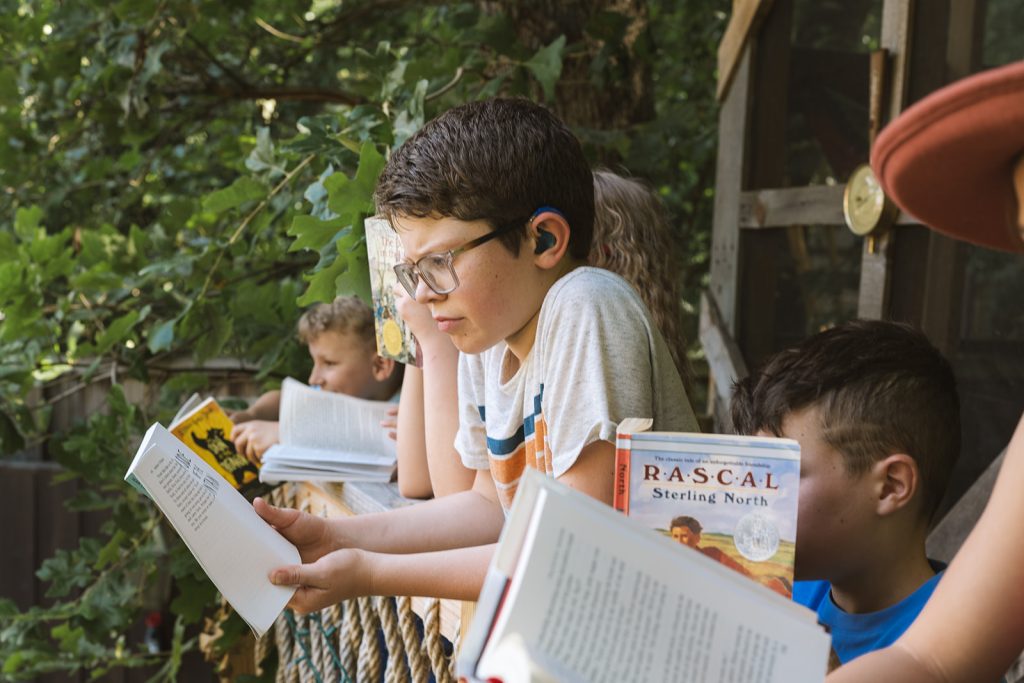Each year as we taper off the holidays and wait for spring to come, I notice how working through our curriculum and schoolwork can begin to feel burdensome and difficult. I call this the winter blues, when the newness of winter wears off and starts to feel tiresome and dreary. In my years of homeschooling, sometimes the effort of continuing the daily rhythm that was fun a few weeks ago falls flat.
When I notice these feelings about our daily routine, I prefer to mix it up instead of forcing us to go through the motions. My goal is to adjust my attitude and encourage my children to find our way back into a light and engaging way of going through our schoolwork rather than keeping at something that isn’t working. There will always be a time and place for planned and structured days, but I prefer to give myself permission to take a break and re-evaluate as needed.
After all, isn’t that one of the joys of homeschooling? The freedom to shake it up and make adjustments? In this blog post I am sharing some of my favorite ways to beat the winter blues.
In this blog post:
- 16 ways to beat the winter homeschool blues
16 ways to beat the homeschool winter blues
1. Take a week off and play!

The easiest way to get out of a rut is to set aside the books and give everyone a break. I find this is especially life-giving if we are coming off a busy season of travel and holiday fun. Let your children play together or with friends and just enjoy themselves. Ask your children what they are in the mood to do, and do that! I am always surprised at how refreshing it feels to have an unstructured day and let them have unlimited time to play together or dedicate themselves to a hobby or craft.
2. Evaluate what is working and what needs to change.

Audit your homeschool planner and try to pinpoint what is working and what needs to shift.
Is there a specific curriculum you or your kids are struggling through? Is there a part of your week that you are excited about or your children look forward to each week? Is a particular time of the day, like the mornings or the afternoons, extra challenging? Are you trying to fit in too many things where you are feeling overwhelmed or rushed?
Give yourself the freedom to add or subtract things from your daily schedule to find what works best for your family in this season. After you re-evaluate, mix up your visual schedule to let your children see the new routine and see how it goes.
3. Do something for yourself.

When I look at my life and talk with homeschool mamas in my community, I find it is easy to shift into a role where our entire life is geared toward our children. I am a dedicated mother and wife, but there are times when I need to take a break, spend time alone, and do something nice for myself. I need to do this from time to time to be able to give my best to my husband, my children, my business, and other endeavors in my life.
Of course, there are so many ways to do this. There are small things you can add to your day and things that are a splurge. Do what works for you. I like to get up early before my children wake up and spend time reading my Bible and in prayer. I also get up and get dressed to start the day. Other times, I will get out of the house and get myself a coffee at a nearby cafe, get a pedicure, or plan a walk through the woods with my sister. You could get a massage, read a book, or take a bath after the kids go to bed. There are always little ways you can check in with yourself and fill up your cup.
4. Take a break from screens.

We try to keep our children off of screens and engaged with the enriching moments of life. But many times as parents who need technology and phones for daily tasks, it is easy to get pulled in and distracted by our devices. When I am feeling distracted, irritable, or notice I am comparing myself to others, it is a reminder to put my phone away and focus on the things that are in front of me, like my children and my own mental health. This helps me recharge and come back more present, creative, and ready to take on new challenges.
5. Get in movement where you can.

When I am feeling stagnant or low-energy, I notice that simple movement like short workouts or daily walks are incredibly life-giving. Even just a 10-minute walk outside or a short workout video, like yoga or stretching can help me reset.
When my children are showing signs of fatigue or frustration, I encourage them to move as well. We may turn on music for short dance party, or I take them outside to run around, ride bikes, or jump on the trampoline. With breaks for movement we all come back refreshed and ready to go.
6. Remember this feeling is normal.

Give yourself permission not to love every aspect of homeschooling or parenting. Homeschooling is hard, and parenting is hard! A lesson I have learned many times is that once I have something figured out, a new challenge comes along.
Burnout, the emotional, mental, or physical exhaustion brought on by prolonged stress, is a normal and valid experience. If you are starting to notice signs of burnout, like feeling irritable, angry, or overwhelmed with no end in sight, discuss it with your spouse, family member, or close friend and work towards a way to find relief.
Some things are hard, and that’s okay. Feeling like aspects of parenting or homeschooling are hard doesn’t make you a bad parent. Hang in there, you’ve got this! We’ve all been there.
7. Mix things up with a fresh unit study.

Is it time to add something new to your days? A fresh unit study can mix it up while still overlapping with many of your school subjects. Dive into winter nature study to lift your spirits with new activities, books, and learning materials. Plus, winter nature study is the perfect way to learn to appreciate the season around you and see what delight it offers.
8. Start a new read-aloud.

If you’re spending more time indoors due to winter weather, pick a chapter book to read-aloud and make a focused effort on reading to your kids. Read a book of the Bible together, or read your children a book you loved as a child. Do a book study to discuss the book together and then make recipes and projects that connect to the story.
9. Re-organize your homeschool space.

When I enter the doldrums of homeschooling, freshening up my space always reinvigorates me.
For me, this means emptying out cabinets to purge and reorganize. It usually gets worse before it gets better.
But ultimately, simplifying my space always makes me feel more relaxed, and it helps me envision what’s next. Take down old projects and make space for what you will study next. File away the pieces you want to save, and get rid of things you don’t need. If you have been holding onto a lot of old curriculum, consider lending it to others who can use it, or selling it at your local homeschool consignment store. (Here’s mine if you’re located in North and South Carolina).
Organize your homeschool area to make it more functional and useful to you. I have always enjoyed having open shelving to display books, art, poems, and pieces we are studying. For larger objects, I used bins and baskets to keep things tucked away and out of sight. For all of my favorites, check out my Amazon storefront.
10. Add “gameschooling” into your homeschool routine.
I have found that “gameschooling” is a great way to enrich our regular homeschool studies, especially when we need a break or change of routine. It’s also a great strategy for getting over a “hump” in learning something specific that a child may be struggling with.
This blog post lists my favorite games for preschool, math, language arts, science, and more!
11. Add a moment for poetry tea time.

One simple thing I always have in my back pocket is tea time. Bake or pick up a special treat, set the table, light a candle, and read poems aloud for your children. This can be set to a theme, time to work through some of your language arts curriculum, or just some of your favorite books and stories. Finding small ways to make our day special can go a long way toward re-energizing us.
12. Plan some one-on-one time with each child.

I know we all value connection with our children, and one way to improve this is to add one-on-one time with each child. Sometimes when I am feeling weighed down by our daily routine, I am also feeling distracted or disconnected.
This can be as simple as setting aside time to read books aloud. You could let your children each take turns staying up an extra hour after their siblings go to bed to do something special with you. You could play a game together, create a special treat together in the kitchen, work on a project together, or just spend time in conversation together.
Hopefully, when it’s time to get back to your daily homeschool rhythm, you and your children will feel equally refreshed, attuned, and ready to tackle the day.
13. Change the scenery for homeschool lessons.

Changing your surroundings for your homeschool lessons is an easy way to add variety. When the weather permits or the sun is shining, lay out a blanket on the grass and sit on the back porch to work through lessons together. Let kids do homeschool lessons in a tent, fort, or other spot they love in your home.
14. Sign up for an enrichment class.

It may help to look for learning opportunities to give life to your school days. Many times I have decided to mix things up and lighten my load for homeschooling with an enrichment class. I love to enroll in these classes for hands-on subjects, like science or chemistry.
15. Write a letter to someone you love.

If you’re stuck indoors, writing letters is a simple way to practice writing, handwriting, sentence and paragraph formation, grammar, and build relationships! It’s basically a language arts lesson wrapped in a fun package.
This is something children can do at their own skill level. In my family, my little ones can draw pictures and tell me what they want to say to grandma or a friend, and I can write the words. Older children write a few sentences or paragraphs. My children have done everything from drawing pictures to writing jokes, stories, and general notes. Sometimes they use stationary and other times lined or computer paper.
16. Plan an adventure.

Flexibility is one of the biggest advantages of homeschooling! Visit the library, the zoo, or a museum. Attend a play or a concert nearby. Plan a road trip to visit friends or family, or check off exploring a landmark you want to show your kids. Search online for things in your area you’ve never explored, like historical markers, birding trails, new parks, or local arts. Getting out of your home and teaching your children to enjoy life is something they will never forget.
What do you do when your homeschool needs a change? Share how you mix things up in the comments below.

![Best Educational Board and Card Games for Kids and Families [2026]](https://storage.googleapis.com/treehouse-schoolhouse-media-dev/d9b5ca6e-image-scaled.jpg)

